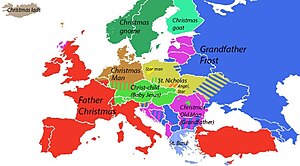This article needs additional citations for verification. (October 2012) |

A number of Midwinter or Christmas traditions in European folklore involve gift-bringers. Mostly involving the figure of a bearded old man, the traditions have mutually influenced one another, and have adopted aspects from Christian hagiography, even before the modern period. In Eastern Slavic countries, the figure is Father Frost. In Scandinavia, it is an elf-like figure or tomten who comes at Yule (and who sometimes also takes the form of a goat). In German-speaking Europe and Latin Europe, it became associated with the Christian Saint Nicholas. In some parts of Central Europe, there is a separate tradition of a young child or fairy-like being bringing presents, known as Christkind. Early modern England had Father Christmas, a character initially associated with feasting and good cheer, though he was not originally a gift bringer.[1][2]
From these European traditions, the North American figure of Santa Claus developed, beginning in the 1820s. The American figure in turn had considerable influence on the various European traditions during the 19th and 20th centuries. In England, for example, Father Christmas gradually took on the attributes of the American Santa Claus during the 19th century, the two characters eventually becoming indistinguishable.[1]
- ^ a b Roud, Steve (2006). The English Year. London: Penguin Books. pp. 385–387. ISBN 978-0-140-51554-1.
- ^ Hutton, Ronald (1996). The Stations of the Sun. Oxford & New York: Oxford University Press. pp. 117–118. ISBN 0-19-820570-8.